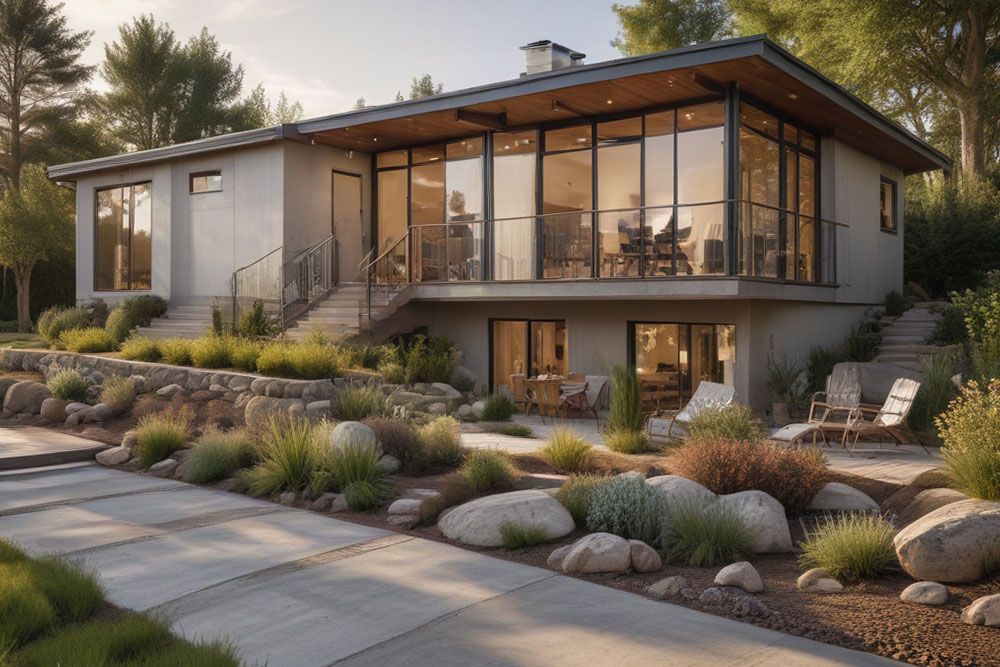Types and Benefits of Modular Homes
Modular homes are a type of prefabricated or prefab homes that are built off-site in a controlled factory environment. These could be built in sections, semi-constructed, or as a whole. The constructed components are then transported to the site where they can be assembled on a permanent foundation. Modular homes are built with more precision than traditional on-site constructions. Not all prefab houses are modular; there are different types and prices for different modular homes.
Types of modular homes
The modular housing market has grown rapidly. It offers a diverse range of designs and sizes to suit different lifestyles, budgets, and site constraints.

- Single-family modular homes
These homes are designed to accommodate the typical needs of a family. They offer multiple bedrooms, bathrooms, and shared living spaces and can be customised with open-plan layouts, modern kitchens, and energy-efficient features. Single-family modular homes are available in both traditional and contemporary styles.
- Modular bungalows
These modern modular homes are single-storey houses ideal for retirees. Modern bungalows take into consideration individuals with mobility issues or those seeking a more compact living space. Despite their smaller footprint, they offer spacious layouts with all the amenities of a larger home.
- Two-storey modular homes
For growing families or those needing additional space , two-storey modular homes are an excellent option .
- Luxury modular homes
Built with premium materials and high-end finishes , luxury modular homes often feature bespoke architectural designs, smart home technology, underfloor heating, and eco-friendly installations such as solar panels. The flexibility of modular construction allows homeowners to personalise every detail, from layout to interior decor.
- Flat-pack homes
Often referred to as kit homes, flat-pack homes are delivered in parts and assembled on site . They are typically more affordable than fully assembled modular homes. While such homes can be constructed with a degree of DIY involvement, professional help is recommended for more complex designs. Flat-pack homes are popular for their cost-effectiveness, quick build times, and versatility.
- Tiny modular homes
With the rise of minimalist living, tiny modular homes have become increasingly popular. These compact homes typically range from 100 to 400 square feet and are designed to maximise space efficiency without sacrificing comfort. Tiny modular homes are ideal for individuals or couples looking to downsize, reduce their carbon footprint, or embrace a more sustainable lifestyle. They are also popular as secondary residences or holiday homes.
Benefits of modular homes
Modular homes are not just a modern trend; t hey offer several benefits over traditional construction methods. These tangible reasons make modular houses an appealing alternative to brick-and-mortar builds.
- Faster build time
One of the standout benefits of modular homes is the speed of construction. Building in a controlled factory environment eliminates delays caused by adverse weather conditions, which are commonly faced problems in traditional on-site builds. On average, modular homes can be completed 20% faster than conventional homes. So, homeowners can move in sooner, reducing temporary housing costs and financial expenses.
- Construction standards met
Modular homes are built to meet or exceed the same building standards as traditional homes. The factory setting allows for precise measurements, consistent quality control, and rigorous inspections throughout the process . This results in fewer construction defects and higher overall quality. The use of technology also ensures that each module fits together perfectly, reducing the risk of structural issues.
- Lightweight structures
Modern modular homes are significantly lighter than traditional masonry homes. This gives homeowners a range of possibilities for site selection. Modular homes are particularly suitable for plots with size restrictions or urban infill projects with limited access. Despite being lighter, modular homes are incredibly strong and durable. And with their design flexibility, homeowners can choose from a variety of styles, layouts, and finishes. This ensures the home meets their specific needs and tastes.
- Eco-friendly option
Sustainability is at the heart of modular construction. The controlled factory environment minimises material waste and allows for the efficient use of resources. Additionally, modular homes are often designed with energy efficiency in mind. It helps incorporate features like triple-glazed windows, superior insulation, and renewable energy systems like solar panels. The reduced construction time also lowers the carbon footprint compared to traditional builds. Further, the on-site assembly causes less disruption to the surrounding environment. Overall, modular homes are a greener choice.
- Cost reduction and affordability
One of the factors that makes modular houses appealing is the overall affordability. Modular home prices are generally 20-30% cheaper than traditionally built homes, making them an attractive option for first-time buyers. Downsizers and those looking to invest in sustainable housing can also easily do so with the range of benefits and higher affordability.The cost of modular homes can vary widely depending on factors such as size, materials, location, and the level of customisation. A simple, entry-level modular home with minimal customisation can typically cost between £30,000 and £80,000. These homes are often smaller in size and come with standard finishes, making them ideal for first-time buyers or those looking for budget-friendly options. One can explore and compare different modular home companies nearby to make an informed decision.
- Reduced labour
Since much of the construction happens off-site, modular homes require fewer on-site workers, resulting in reduced labour costs. The streamlined factory setup further simplifies the process by eliminating the need for multiple subcontractors. It also helps avoid the likelihood of delays or cost overruns. Additionally, the faster build time means that financing and interest costs are lower compared to traditional construction.

